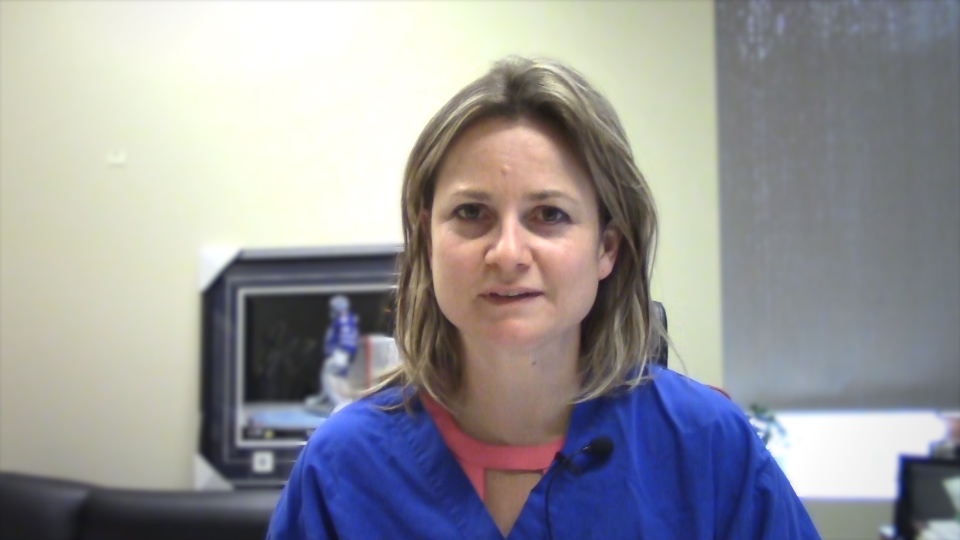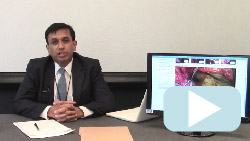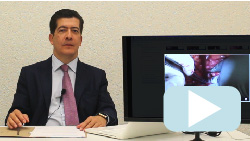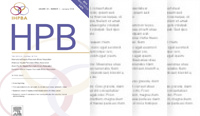International Hepato-Pancreato-Biliary Association
Whipple (pancreaticoduodenectomy) [case 7]
Post-op Debrief
Watch the following videos for the surgeons summaries of the case.
Key points from this case
Kocherization: kocherizing the duodenum early on in the procedure can give you more control if you encounter bleeding.
Tumor margins: when tissue is abnormal and the pancreatic duct is dilated, evaluate the margins for anastomosis.
The issues that the surgeons collectively identified preoperatively:
- Cystic lesions in pancreas head and neck
- IPMN (Intraductal Papillary Mucinous Neoplasms)
- Dilated pancreatic duct
- First jejunal branches of SMV
- Adipose tissue
Dr. Moulton | Dr. Shrikhande | Dr. Lillemoe
Dr. Moulton
The issues were demonstrated in the OR Footage videos. This is a debrief on our patient who had a Whipple operation for an ampullary carcinoma. I believe the diagnosis was correct. There was a mass around the ampulla and there’s certainly cystic lesions throughout the pancreas.
There was one emergent slowing down moment. One of the branches of the middle colic vein actually tore off of the superior mesenteric vein. So that was an interesting few minutes trying to get control of that, which we did, actually with a very good maneuver which we should talk about.
Very early on in a Whipple operation, particularly before getting the tunnel first actually kocherize the duodenum because if there is any bleeding, as you get the tunnel or any avulsion off the SMV or portal vein, splenic vein bleeding, you can very easily then do bimanual palpation. My left hand can go around behind the duodenum, and behind the head of the pancreas and push up on the portal vein or the SMV and then my thumb can actually push down on it. So if there’s any bleeding, you can control it very nicely with one hand. Taking your thumb off that you can actually see where the defect is in the vein, which I think you’ll see quite nicely on the video.
Then if you have some time to then call for help, change your lighting, get the room prepared and then decide what you need to do with it. Whether it's a suture, a 6.0 or a 5.0, or ligation of the branch that had been avulsed. You can get quite impressive bleeding out of any of these veins that come off the portal vein or SMV.
The other planned slowing down moment was the neck of the pancreas and because of his IPMN, it was quite unusual as we cut across the neck. He has a lot of adipose tissue, his body mass index is quite high and there was a lot of adipose tissue actually in the pancreas itself. We had to take a layer of adipose tissue off the front of the pancreas to get to the normal pancreas. Even as you divided the pancreas, the pancreatic substance wasn’t normal, and then the cyst and the duct were very very dilated when we came across it. We could see inside the cyst actually that the duct normalized about a centimetre away from where we divided it so we actually then took another centimetre-and-a-half of pancreas and then came across a smaller duct and we felt more comfortable anastomosing to.
Dr. Shrikhande
I have viewed the intraoperative footage of this case that was done and there were certain 4 or 5 clips that have been made available to me. I’ve seen them and I’m glad we have discussed some of the issues already when I discussed with you the CT scan as well as the slowing down moments.More specifically, if you recollect, the slowing down moments I did mention about the wide mobilization of the hepatic flexure of colon right down, because that facilitates a more easier, and wider and a complete Kocher maneuver. The purpose of doing a complete Kocher maneuver is twofold. One is to assess the extent of the tumor and its relationship to the superior mesenteric vein and the portal vein. But the other part is also to assess the general friability of vessels and to get these vessels from the transverse mesocolon (i.e. the middle colic and the other colic vessels), as they drain into the superior mesenteric vein. Any undue traction on this can result in bleeding. It was very nicely shown in the video that if you have a bleeding, what should be done. So I always say there are two things: one is try and avoid getting into this situation by always first doing a nice Kocher maneuver by mobilizing the hepatic flexure of colon away first; this will always give you the access to a blood vessel -should the blood vessel start to bleed. And with a bi-manual palpation, you can control it with your finger, you can keep the operative field clean. You can calm down the surgeon who is helping you, even if it’s a young trainee surgeon and you have things in control and just to suture with a fine prolene or even a clip would do the job because these are usually the small tributaries draining into the SMV. So this is step number 1. Secondly, if it does happen like this, the way I saw it in this video footage, then of course they had to mobilize the hepatic flexure of colon a little bit later and then do the Kocher maneuver well, and then get the bi-manual palpation during which time there was a degree of bleeding which was avoidable in my opinion. That’s part number 1.
Then would I change my plan of what we have already discussed before? No. I’m glad this patient has received a good Whipple resection. The pancreatic transection margin as I spoke about, very clearly a big dilated duct. So I would be keen to know the status of the dilated duct. Whether the duct dilatation was only because of ampullary pathology-causing or ampullary block or whether there is associated IPMN-like changes. If there is moderate dysplasia at the neck, the thing that I would do is to revise the neck once again, rather than trying to be more radical because moderate dysplasia is a risk factor. Mild dysplasia I will ignore and just go ahead with a safe pancreas anastomosis.
Another variation is that I saw the pancreatic transection with the help of an electrosurgical generator, I think it’s a cautery. You can use different energy devices, like a harmonic scalpel or a pancreatic transection is done by a cautery but I’ve also seen surgeons do it with a knife because pancreatic vascularity, that too in an 83-year old gentle man, can be a source for concern based on some data. Which is not a very high level of evidence but which is nevertheless documented in literature. The last thing you want in this patient is a leaking pancreatic anastomosis because of ischemia problems. Always good to remember that a pancreatic anastomosis should be done by respecting all the principles of a good anastomosis by Halstead. You want good vascularity, you want perfect anatomical approximation, you want gentle handling and inspecting of the tissues, you don’t want any distal obstruction and all these 4 things can be ensured only by the chief operating surgeon in the middle of a difficult operation because you are finished a good resection or a difficult resection and now you have to do a difficult anastomosis is what I realized in this case that though the duct was dilated, the rest of the pancreas was fatty so it's a friable pancreas with a dilated duct which also would have to be done with great care.
The last footage that I saw was dissecting the uncinate process off the SMV. So there I have a slight difference of opinion in the sense that I have seen the CT scan pictures with the dilatation and we always know that it's the medial margin of the pancreas which can be an R1 resection postoperatively on final histopathology. Even for small ampullary tumors, up to 7-10% of cases can harbour disease at the margins. The medial margins of a Whipple resection. So although we dissected off the SMV, we also dissected off the SMA. And again to take you back to the first step, the wide Kocher maneuver with the hepatic flexure going down, at that time you need to mobilize things in such a way that you are able to expose the superior mesenteric vein and the artery on the right side without dissecting the adventitia of the superior mesenteric artery because then you are in a perfect avascular plane/anatomical plane; you have a complete sense of control and you will get the uncinate process out in complete totality, and reduce the chances of local recurrence and also improve the chances of an R0 resection. What I said is more important for a pancreatic head and uncinate process lesion. But in this case because of the dilatation, again, I was aware that one can have areas which might be involved by disease though I did not anticipate in this case. I do not have access to the final histopathology of this case but this is what I would do a little differently from what I saw in the video when it came to dissecting the uncinate process of the superior mesenteric vein.
Dr. Lillemoe
Clearly some of the things that I anticipated in advance from looking at the imaging came into play. As demonstrated here in one of the very first maneuvers, they got into bleeding with a branch of the middle colic on to the SMV. I agree totally with the surgeon, a generous Kocher maneuver. I extend the Kocher maneuver all the way over to the ligament of Treitz. Find the SMV low and begin its dissection from below the so-called trunk where the gastroepiploic and the colic vein often come into. But I would agree particularly in a patient with central obesity that just a little extra pull - that these avulsion injuries can happen early, they can happen quick, they can lead to significant blood loss. I typically will apply Allis clamps. I watched as the stitches were being placed with one hand below sort of controlling. That's hard to do. I'd want to make sure that we have all four hands available so if I have a avulsion injury I try to get control with Allis clamps first. Stop the bleeding to look at the vein and then to make sure that as I put those stitches in, that I do not narrow the SMV at that point. It's clearly different if you're dealing with cancer as opposed to this situation where you're not dealing with tumor involvement along the SMV but in this case I thought they handled it well.
The next step as I would have proceeded is exactly as was done in this operation dividing the - its usually I think a trunk with three vessels including the gastroepiploic. I do agree with ligating it as close to the SMV as you possibly can. Usually it requires ligation of all three vessels that feed into it. There's a small one that usually comes directly from the head of the pancreas. Again a lot easier in a case like this where there's no cancer involved such as the ampullary tumor that we were doing with here.
The pancreatic transection as I suggested in my review. I didn't hear what the frozen section mentioned but clearly I agree with trying to resect all that bile duct. The last thing you want to do is resected bile duct and have the final pathology come back main duct IPMN with high grade dysplasia. The resection further to the left was completed. What that does though is it goes from a big generous pancreas duct for reconstruction to a small narrow duct in a soft gland. I like to say ampullary cancers are usually the easiest to take out but the most likely to have a post-operative complication of leak because of the soft fatty infiltrated gland with a non-dilated pancreatic duct. I thought they handled the transection well.
Finally the uncinate process dissection as I said I tend to mobilize the SMV and identify the SMV quite low and work my way up. And so the peeling the SMV and the portal vein, off the uncinate process is again it's a very meticulous dissection. There are very short branches of the portal vein and SMV that come into the pancreas that have to be individually ligated. I agree that it's tough to do that with any type of a thermal device so I individually divide those as well. One of these small branches can look very tiny but if you tear it all of a sudden it looks bigger and the more you work on it the more you try to clamp it, the bigger it can get. So meticulous dissection and control of anything that looks like it could be a branch is the right thing to do.
Once I've got the vein up and the pancreas down and the uncinate, again in the case like was mentioned here, again you don't have to worry about the margined on the SMA. I do individually try to find the inferior pancreaticoduodenal artery and I would note too the first jejunal branch is a very constant finding as you're mobilizing the mesentery of the third and fourth portion of the duodenum. Have to be careful if you think there's nothing there and next thing you know you've got a hole in the first jejunal branch and you have to sacrifice it. And if that hole is proximal as was mentioned by the surgeon in the technique description, it can create troublesome bleeding because it does originate more to the left or undersurface of the SMV. So it's tough to get control.
You know doing a Whipple, it's generally the same steps but you really have to know where those areas are that you can get into trouble. That early dissection of the SMV particularly in an obese male, particularly if there's concern about cancer in those areas is key. Identifying the hepatic artery-GDA junction to make sure. Even if you have the anatomy correct, things like celiac stenosis from atherosclerosis or from arcuate ligament syndrome can cause you to lose the pulse. So you want to identify that early. Very meticulous dissection of the GDA so that you don't create a intimal flap as you're dissecting and ligating the GDA's important. So these are all important steps. We didn't look at the reconstruction here but I would expect that the soft gland small duct would have been a challenging pancreatic anastomosis and a relatively straightforward biliary anastomosis to a big duct.
Acknowledgements
Thank you to the HPB Surgeons who contribute their time and expertise. This content is made possible through educational grants from:

![]()
Views and opinions expressed in all videos and module content are those of the individual surgeon and solely intended for surgical education purposes. We do not endorse any product, treatment or therapy.
Corporate Partners
If you are interested in becoming a Corporate Partner of the IHBPA please contact industry@ihpba.org
Find out more







